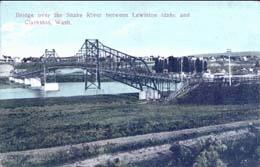On June 24, 1899, the Lewiston-Clarkston Bridge, the first bridge to span the Snake River between Washington and Idaho, opens for traffic. The 1,700-foot-long bridge connects Clarkston, Washington (Asotin County) and Lewiston, Idaho. The span is a toll bridge; fees are five cents to cross if you are on foot, ten cents if you are on a horse or in a wagon.
For centuries, the only way to cross the Snake River in the northern part of Asotin County was on the old Nez-Perce Trail. The trail crossed the river at the Red Wolf Crossing below Silcott, about seven miles west of present day (2006) Clarkston, Washington.
In the 1860s, a few white settlers first reached the area that would later become Clarkston, but it was the mid-1890s before Clarkston (briefly known first as Lewiston and then as Concord between 1895 and 1900) and adjacent Vineland began to experience significant population growth. (Vineland was absorbed into Clarkston shortly after 1900.) By 1900 the Clarkston-Vineland population was approaching 2,000. The area’s main trading center, Lewiston, was just across the Snake River from Clarkston. Ferries crossed the river, but the area’s sudden population surge between 1895 and 1900 made it more difficult for ferries to handle the increasing traffic. At this point a bridge across the Snake River became practical.
The original bridge franchise was granted to Edgar H. Libby by the city of Lewiston, Idaho, on May 18, 1896. However, it was not until November 26, 1897, that the Lewiston-Concord Bridge Company filed articles of incorporation in the auditor’s office in Asotin, Washington. Incorporators were Libby, a Lewiston resident and manager of the Lewiston Water and Power Company, and George Bailey, a lawyer from Asotin. Congress chartered the bridge by a special act on February 15, 1898, and the contract was let on October 26, 1898.
Construction of the bridge began on December 15, 1898, and progressed rapidly through the winter and spring. The bridge was completed at a cost in 1899 dollars of $110,000. When it was completed, the bridge was 1,700 feet long and weighed over 10 million pounds. It contained 636 tons of steel, and the wooden deck and rails contained 200,000 feet of lumber. The bridge was a high arch, cantilever structure that was high enough above the river to allow steamboats to pass underneath with considerable clearance.
Although the bridge opened for traffic on June 24, 1899, the “official” opening of the bridge was on July 4, timed to coincide with Independence Day. The official opening was quite a ceremony, and attracted numerous residents and officials from the surrounding area.
The bridge remained a toll bridge until 1913, with J. L. Kerns as toll collector for those 14 years. His contemporaries recalled him as often working 18 hours a day at the bridge. Fees to cross the two-lane bridge were five cents by foot, and ten cents by horse or wagon. Horses were required to walk, not run; the fine for running a horse on the bridge was $10. A pedestrian walkway was on the south side of the bridge, and between 1915 and 1928, streetcars ran along the north side.
In 1913 the states of Washington and Idaho planned to each purchase one-half of the bridge. The Washington State Legislature authorized a bond issuance to pay for its half of the bridge’s purchase, but the Washington Attorney General declared the proposed bond issue illegal. Asotin County completed the purchase with Idaho. The bridge’s tolls were lifted on December 4, 1913, and both states maintained the bridge as a free bridge through the 1930s.
By the late 1930s steadily increasing traffic made it necessary to build a larger bridge, and a new four-lane bridge across the Snake River was built just north of the original Lewiston-Clarkston Bridge. This new bridge opened May 26, 1939, to much fanfare. The original bridge was closed, dismantled, and melted down into scrap iron.

